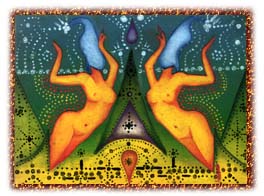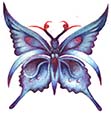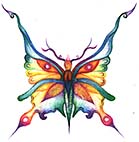|
|
|
As I exhaled, the smoke formed into wondrous colourful curlicues... a smokey 3-D persian carpet that shimmered and lingered in front of me as the haze dissolved. A strong psychedelic rush rose up my spine. My first thought (if you could call it that) could be translated loosely as "What the FUCK???". Intuitively, I sucked in a few more deep puffs and strummed determinedly as I clung on for dear life. Long experience in playing music on psychedelics had taught me that if you keep strumming through the first rush, you can often ride the whole thing to new and interesting places. Fortunately, most of the other musicians in the circle had also learnt the same lesson and a splendid time was had by all.
A few months later, myself and a close musical friend, Peter (who shared my predilection for extreme psychedelic experience) had been booked to play a set at a local market. It was one of those hectic fund-raiser affairs so beloved of hippies. A benefit gig with literally dozens of acts booked to play fifteen minutes each. A nightmare for the stage manager and (truth to tell) usually not much fun for the musicians either.
Now it's worth pointing out that this was all synthesised DMT as opposed to the various more organic extracts that started popping up 20 years later and are now (40 years later) a primary status symbol in the dreadlocked, jet-set, beautiful people posse. The Pranksters, the Grateful Dead, Tim Leary's scene & various other psychedelic cognoscenti all had access to this stuff back in the 60s. The more educated amongst us 70s hippies knew this. Some of us even knew that it was first synthesised in the 30s and that the Hungarians were the first Europeans to note its psychotropic effect back in 1956. We even knew that in plant form it was a principal ingredient in the South American shamanic potion "Yage" that Ginsberg & Burroughs had gone looking for in the 50s. It was a good 10 or 15 years though before Terence McKenna achieved psychedelic celebrity and started describing DMT elves and overwhelming out-of-body experiences on the tryptamines. Obviously, for it to be effective in a joint one had to mix it with other herbs. Grass was fine by me as was tobacco... but not everybody liked grass or tobacco so more neutral inert substances were usually substituted. Peter Stafford's Psychedelics Encyclopedia gave a simple description of how to dissolve DMT in alcohol, soak herbs in it and then evaporate the alcohol... creating a smoking mix. This method remained popular throughout the 70s, 80s, 90s & into the 21st Century. As a result of my 70s DMT experiences, I spent the next 15 years with one eye open for any more that I could wrap my lungs around. Every so often, some would find it's way to our neck of the woods but generally it was a rare treat. Sometime in the early 90s, it started to become more commonly known that the Australian Acacia (or wattle) tree contained quite useable amounts of DMT and that it was a simple matter to extract it. Suddenly it was no longer a rare treat for the entheogenic cognoscenti but became instead a staple part of the local psychedelic arsenal. Consumed regularly in all sorts of social situations... its distinctive aroma could often be smelt at mid 90s doofs as the younger fraternity discovered it. At the same time, we older hippies were also making use of the wattle. The band I was in regularly smoked a joint of it onstage for our final piece of music. These were not usually "heroic" full-blown psychedelic doses but a more measured controlled amount... just enough to make it interesting. 
In Nimbin at the same time a regular annual drug law reform rally (the MardiGrass) was taking place. Part of the yearly celebrations was the Cannabis Cup- an Amsterdam-style event where various local strains of ganja were sampled and voted on by a panel of "experts". Some of the locals felt it was a bit futile to attempt to accurately judge a large variety of strains in one brief afternoon session. So in best Nimbin-style anarchic fashion, a bag of pot soaked in DMT was entered. Once again, not the sort of dose that would leave you flat on your back... just enough to see the colours and know that you were tripping... a mild religious experience as it were. Initially, much derision was aimed at the DMT-flavoured entrant (clearly labeled "Death- don't say we didn't warn you", in a bizarre synchronicity, it was Number 23 in the comp). Admittedly, it only comprised small unimpressive buds with a decidedly weird smell to 'em but people were encouraged to at least try it. Within a short time, the room was filled with the semi-acrid aroma of DMT and the crazed laughter and sighs of the many that kept sampling it... often again and again. It proved very popular and would've probably won the competition if it hadn't been disqualified by an organiser who (once again) didn't really like tripping. Other organisers though could see the humour in it all and presented those that had entered number 23 with a printed poster, proudly proclaiming that they'd been "officially disqualified from the 1997 Nimbin Cannabis Cup". By the early 21st Century, smoking mixes containing a variety of herbs soaked in DMT were commonplace... and then someone with a strong marketing vision and an instinct for self-promotion decided to call it "changa". 
|
...or just...
Get me the hell outtahere!!!
-CONTACT-


